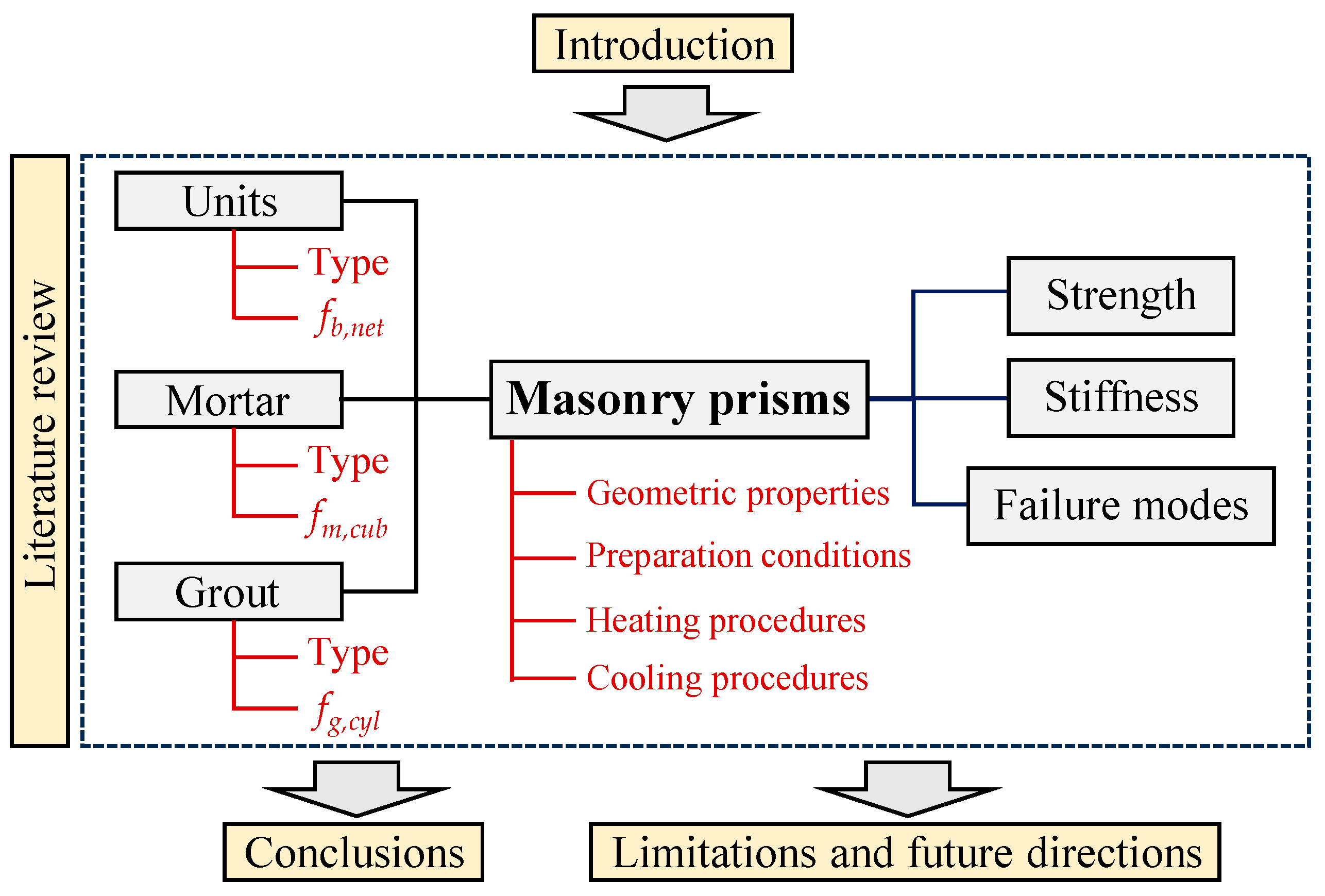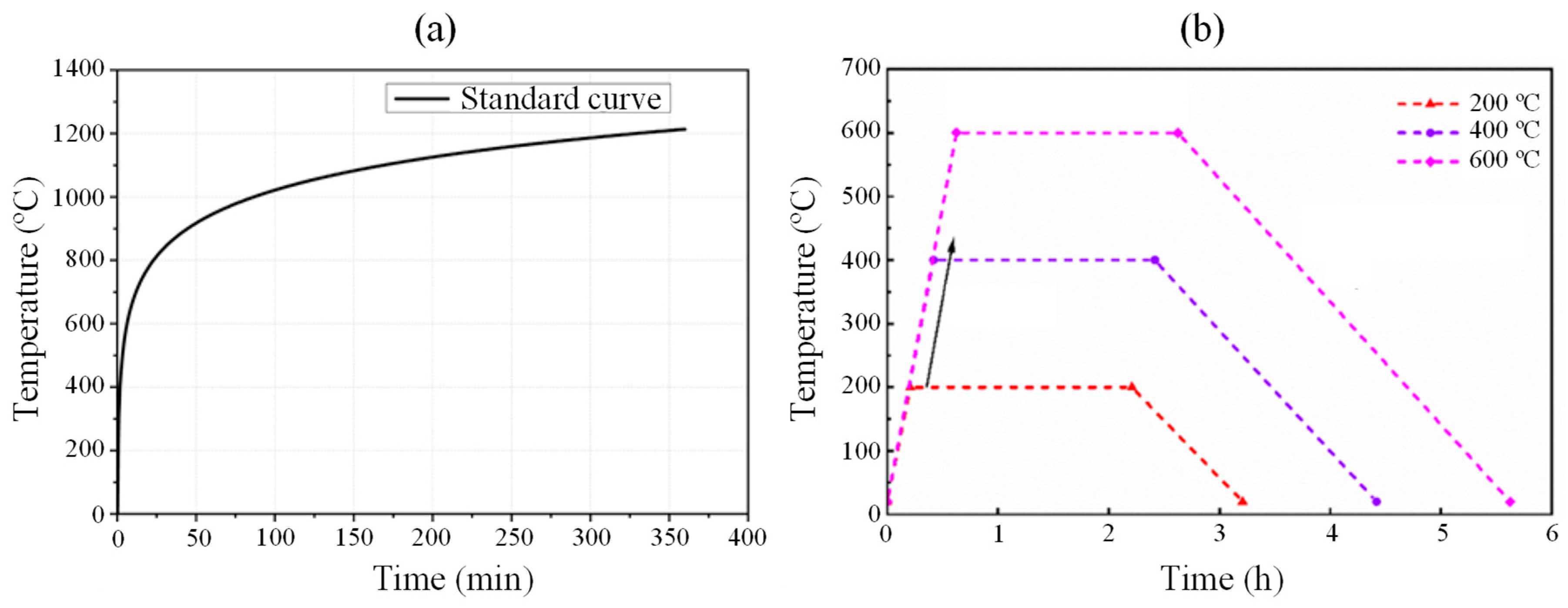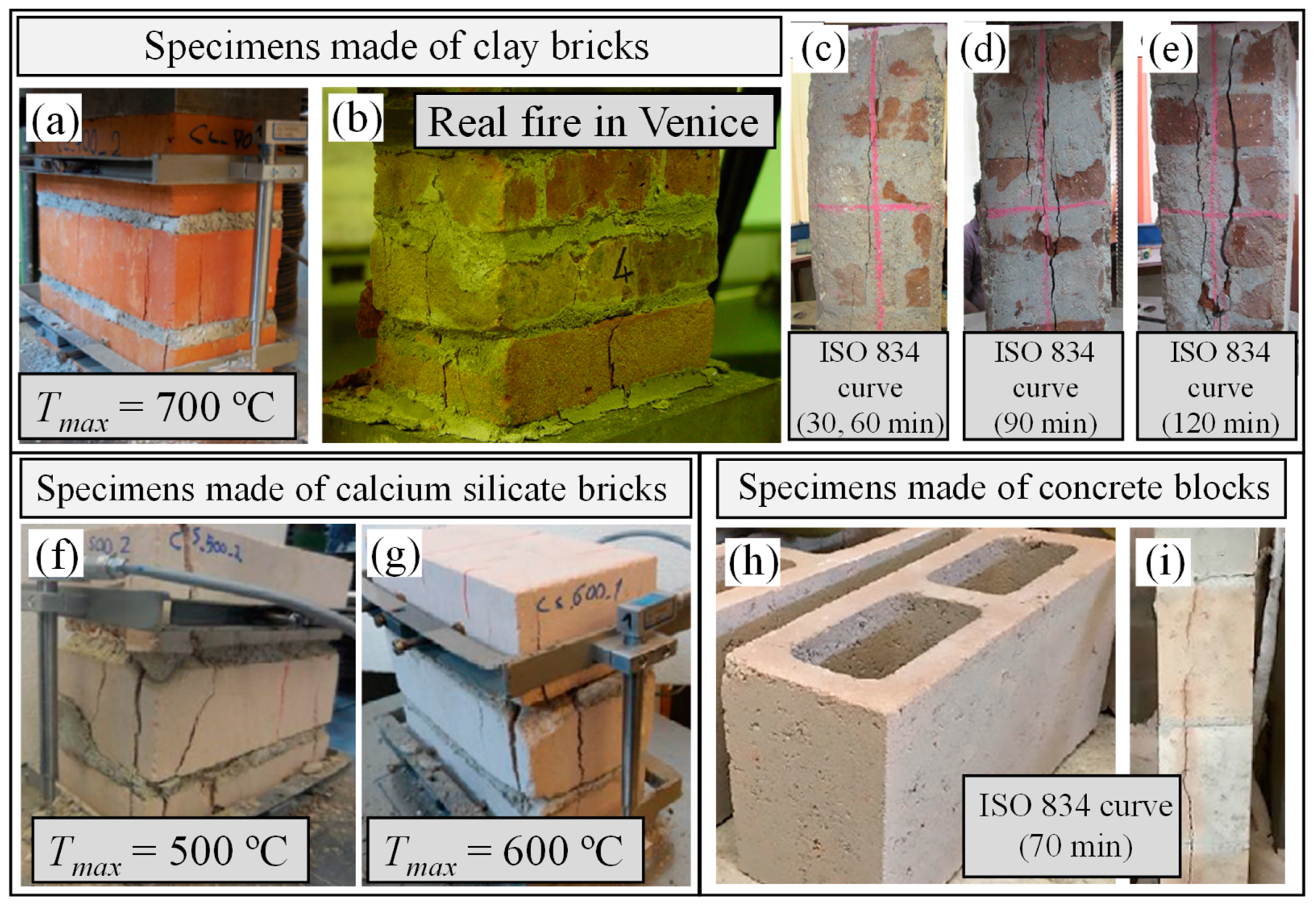Review of Recent Progress on the Effects of High Temperatures on the Mechanical Behavior of Masonry Prisms
Abstract
1. Introduction
2. Effects of High Temperatures on Masonry Prisms
| Authors | Units (a) | Mortar | Grout | Prisms | |||||||||||
|---|---|---|---|---|---|---|---|---|---|---|---|---|---|---|---|
| Type | Length × Width × Height (mm) | fb,net (b, c) (MPa) | Material | fm,cub (c, d) (MPa) | Material | fg,cyl (c, e) (MPa) | Rendering | Joint Thickness (mm) | Heating Rate (°C/min) | Time at Maximum Temperature (h) | Maximum Exposure Temperature (°C) | Cooling Method | Investigated Mechanical Properties | Capping of Prisms after Fire and before Mechanical Tests | |
| Gao et al. [35] | Solid clay brick | 240 × 115 × 53 | 16.32 (0.47) | Cement mortar | 29.38 (0.73) | - | - | Various reinforced layer types (f) (15 mm) | 10 | 16 | 2 | 200; 400; 600 | Natural cooling | fc, load-displacement curves | Quick-hardening cement layer (3 mm) |
| Kiran et al. [34] | Solid clay brick | 255 × 100 × 100 | 7.85 (SD was not presented) | Cement mortar | 13.65 (SD was not presented) | - | - | Manufactured sand, vermiculite or perlite mortar (20 mm) | 10 | Standard ISO 834 curve [36] (30; 60; 90; 120 min) | Natural cooling (outside the oven) | fc, Es, stress –strain curves | Gypsum plaster (10 mm) and plywood sheets (20 mm) | ||
| Leal et al. [33] | Hollow concrete blocks | 390 × 140 × 190 | 7.7 (SD was not presented) | Cement–lime mortar | 6.13 (SD was not presented) | - | - | - | 10 | Standard ISO 834 curve (1999) (70 min) | Natural cooling (inside the oven) | fc (tests at 7 days after fire) | Mineral fiber capping board (20 mm) | ||
| Bošnjak et al. [1,30] | Solid clay brick | 240 × 115 × 71 | 32.6 (SD was not presented) | Cement mortar | 23.4–25.9 (SD was not presented) | - | - | - | 10 | 2 | 2 | 100–1100 | Natural cooling (inside the oven) | fc, Es, stress–strain curves | Without capping (bricks’ surface polished before heating) |
| Solid calcium silicate brick | 28.3 (SD was not presented) | 25.9–27.5 (SD was not presented) | |||||||||||||
| Neto [26] | Hollow clay blocks | 290 × 140 × 190 | 24.3 (3.5); 27.9 (5.5) | Cement–lime mortar | 4.38 (0.9) | - | - | - | 10 | Standard ISO 834 curve [36] (120 min) | Fan cooling | fc, Es, stress–strain curves | Mineral fiber capping board | ||
| Bitten-court and Antunes [31] | Hollow clay blocks | 290 × 140 × 190 | 14.9 (3.6) | Not reported | 11.4 (0.5) | Conventional grout | 67.7 (23.2) | - | - | 3 | 0.5 | 300; 600; 900 | Natural cooling (inside the oven) | fc | Not reported |
| Dupim [27] | Hollow concrete blocks | 290 × 140 × 190 | 42.2 (2.4); 14.3 (1.2) | Cement–lime mortar | 11.5 (1.0) | - | - | Gypsum plaster layer (5 mm) | 10 | Standard ISO 834 curve [36] (70; 120 min) | Fan cooling | fc | Mineral fiber capping board | ||
| 290 × 190 × 190 | 38.1 (2.0); 11.6 (0.8) | ||||||||||||||
| Zhang et al. [32] | Perforated clay brick | 240 × 115 × 90 | 12.9 (0.3) | Cement–lime mortar | 2.5 (0.2); 5.6 (0.3); 10.0 (0.1) | - | - | - | 15 | Standard ISO 834 curve [36] (90; 150 min) | Air cooling (opened oven door if <400 °C); water cooling | fc, stress–strain curve | Not reported | ||
| Rigão [28] | Hollow clay blocks | 290 × 140 × 190 | 11.5 (1.1) | Pre-blended mortar | 4 (SD was not presented) | - | - | - | - | - | 0.5 | 400; 900 | Natural cooling (inside the oven) | fc | Not reported |
| Russo et al. [29] | Solid clay brick | Around 60 × 60 × 60 | 11.4–39.2 (SD was not presented) | Lime mortar | 3.0–31.5 (SD was not presented) (g) | - | - | - | - | Real fire event in a historic brick masonry structure in Venice, 2003 | fc, Es, stress–strain curves | Not reported | |||
2.1. Failure Mechanisms of Prisms Exposed to High Temperatures
2.2. Strength and Stiffness of Prisms Exposed to High Temperatures
3. Conclusions
- Exposure to high temperatures can cause remarkable changes in the failure mode of prisms produced with clay or calcium silicate units, due to increases in the difference between the residual stiffness of the units and the mortar. This increase has been attributed to the significant thermal degradation of the joint compared to the units, so that a premature crushing of the fire-damaged mortar joint was usually observed.
- The effects of fire on the failure mode of concrete block prisms were less remarkable compared to those verified in prisms produced with clay or calcium silicate units. In concrete block prisms, units and mortar joints were all severely affected by the elevated temperatures, leading to slight changes in the difference between their residual stiffness. Then, tensile block splitting, spalling of block portions, and localized mortar crushing were reported in prisms of concrete units.
- Comparisons between the residual strength and stiffness of masonry prisms demonstrated the excellent fire resistance of prisms produced with clay and calcium silicate units, compared to prisms constructed with concrete units. The mechanical performance after exposure to high temperatures was improved when concrete grout was poured into the hollow block prisms. However, the mechanical properties of ungrouted hollow clay block prisms seemed to be more affected by fire exposure than prisms constructed with solid units.
- Experimental tests of masonry prisms have been successfully used to evaluate the effects of different factors on the behavior of masonry exposed to high temperatures. The following factors have been investigated in previous studies: maximum expo-sure temperature of the prisms (using constant heating rate or standard fire curve), type of unit or mortar (solid clay bricks, solid calcium silicate bricks, hollow clay blocks, hollow concrete blocks, cement mortar, lime mortar, and cement–lime mortar), specimens’ rendering type (PVA fibers reinforced layer, mixed PVA/basalt fibers reinforced layer, mixed PVA/steel fibers reinforced layer and ordinary plaster mortar, manufactured sand mortar, vermiculite mortar, or perlite mortar), and cooling method (air cooling and water cooling).
- The good agreement between the compressive strength results of masonry prisms and small walls (before and after exposure to fire) suggested that prisms can be considered simple types of specimens that may provide interesting insights into the residual strength of fire-damaged masonry.
4. Limitations and Future Directions
- The effects of numerous variables on the post-fire mechanical properties of masonry prisms have not yet been investigated in the previous literature. Thus, it is pertinent to evaluate the influence of the following factors on the structural behavior of prisms subjected to high temperatures: time and rate of heating, type of aggregates used in concrete units and mortar joint, geometry of hollow blocks, different slow and fast cooling procedures, moisture content of the prism, relative strength of units and mor-tar, bedding approach, and bonding arrangement.
- Previous studies have only explored the mechanical performance of fire-damaged masonry prisms made with conventional types of units and mortars. Therefore, future studies are recommended to investigate the effects of high temperatures on mechanical properties of prisms produced with high-strength blocks, units and mortars incorporating wastes and recycled admixtures, nanomodified units and mortars, polymer adhesive mortars, fiber-modified units and mortars, and other unconventional masonry components.
- The current knowledge regarding the mechanical behavior of grouted masonry prisms exposed to high temperatures is very limited. Thus, relevant future studies should focus on the compressive behavior of prisms produced with different grouting procedures, prisms made of hollow blocks filled with grout of different mechanical properties, and grout containing different types and dosages of shrinkage-compensating admixtures.
- Future experimental works should be developed in order to increase the available dataset on the residual mechanical strength and elastic modulus of masonry prisms, which could be used to develop more representative stress–strain curve models and empirical formulations for the prediction of prism strength and stiffness.
Author Contributions
Funding
Data Availability Statement
Conflicts of Interest
Abbreviations
| Es | residual static elastic modulus of prisms |
| fb,net | net area compressive strength of units |
| fc | residual compressive strength of prisms |
| fg,cyl | compressive strength of grout |
| fm,cub | compressive strength of mortar |
| PVA | polyvinyl alcohol |
| SD | standard deviation |
| t | time of the heating process |
| Tmax | exposure temperature level |
| qg | gas temperature in the fire compartment |
| q0 | the initial room temperature |
References
- Bošnjak, J.; Gambarelli, S.; Sharma, A.; Mešković, A. Experimental and Numerical Studies on Masonry after Exposure to Elevated Temperatures. Constr. Build. Mater. 2020, 230, 116926. [Google Scholar] [CrossRef]
- Medeiros, W.A.; Parsekian, G.A.; Moreno, A.L., Jr. Critical Analysis of the Use of International Codes and Standards to Design Brazilian Structural Masonry in Fire Situation. Int. J. Mason. Res. Innov. 2021, 6, 285. [Google Scholar] [CrossRef]
- Rodrigues, F.M.; Moreno Júnior, A.L. Temperature Field of Concrete-Filled Steel Tubular Columns in Fire. REM Int. Eng. J. 2017, 70, 137–147. [Google Scholar] [CrossRef]
- Das Neves, N.S.; Camargo, R.S.; de Azevedo, M.S. Finite Element Computational Development for Thermo-Mechanical Analysis of Plane Steel Structures Exposed to Fire. REM Int. Eng. J. 2022, 75, 9–18. [Google Scholar] [CrossRef]
- Pires, D.; Barros, R.C.; Rocha, P.A.S.; Silveira, R.A.d.M. Thermal Analysis of Steel-Concrete Composite Cross Sections via CS-ASA/FA. REM Int. Eng. J. 2018, 71, 149–157. [Google Scholar] [CrossRef]
- Cho, H.; Lee, D.; Ju, H.; Park, H.; Kim, H.; Kim, K. Fire Damage Assessment of Reinforced Concrete Structures Using Fuzzy Theory. Appl. Sci. 2017, 7, 518. [Google Scholar] [CrossRef]
- Ha, T.; Ko, J.; Lee, S.; Kim, S.; Jung, J.; Kim, D.-J. A Case Study on the Rehabilitation of a Fire-Damaged Structure. Appl. Sci. 2016, 6, 126. [Google Scholar] [CrossRef]
- Nalon, G.H.; Ribeiro, J.C.; Pedroti, L.G.; Duarte de Araújo, E.; Franco de Carvalho, J.; Soares de Lima, G.; de Moura Guimarães, L. Residual Piezoresistive Properties of Mortars Containing Carbon Nanomaterials Exposed to High Temperatures. Cem. Concr. Compos. 2021, 121, 104104. [Google Scholar] [CrossRef]
- Russo, S.; Sciarretta, F. Masonry Exposed to High Temperatures: Mechanical Behaviour and Properties—An Overview. Fire Saf. J. 2013, 55, 69–86. [Google Scholar] [CrossRef]
- Torregrosa, M.E.M.; Diez, J.C. Heat Transfer Mechanism and Thermomechanical Analysis of Masonry Structures (Mortars and Bricks) Subjected to High Temperatures. In Reactions and Mechanisms in Thermal Analysis of Advanced Materials; John Wiley & Sons, Inc.: Hoboken, NJ, USA, 2015; pp. 437–466. [Google Scholar]
- Yassin, M.; Adnan, S.; Shahidan, S.; Ali, N.; Kamarulzaman, N.; Roni, N. Strength and Physical Properties of Sustainable Concrete Masonry at Elevated Temperature: A Review. Malays. Constr. Res. J. 2018, 4, 45–55. [Google Scholar]
- Medeiros, W.A.; Parsekian, G.A.; Moreno, A.L. Residual Mechanical Properties of Hollow Concrete Blocks with Different Aggregate Types after Exposure to High Temperatures. Constr. Build. Mater. 2023, 377, 131085. [Google Scholar] [CrossRef]
- Leal, C.E.F.; Medeiros, W.A.; Maebara, A.K.; da Silva, D.H.; Parsekian, G.A.; Christoforo, A.L. Aggregate Type Influence on Strength and Deformability of Structural Zero-Slump Concrete Blocks: Numerical, Experimental, and Statistical Study. Matéria 2022, 27, e20220050. [Google Scholar] [CrossRef]
- Medeiros, W.A.; Parsekian, G.A.; Moreno, A.L. Test Methodology for Determining the Mechanical Properties of Concrete Blocks at High Temperatures. Mater. Struct. 2022, 55, 61. [Google Scholar] [CrossRef]
- Yassin, N.I.M.; Adnan, S.H.; Shahidan, S.; Ayop, S.S. Strength and Physical Properties of Concrete Brick at Elevated Temperature. IOP Conf. Ser. Earth Environ. Sci. 2020, 498, 012054. [Google Scholar] [CrossRef]
- Fernandes Neto, J.A.D.; Sombra, T.N.; Haach, V.G.; Corrêa, M.R.S. Effects of Post-Fire Curing on the Residual Mechanical Behavior of Cement-Lime Masonry Mortars. Constr. Build. Mater. 2022, 327, 126613. [Google Scholar] [CrossRef]
- Sciarretta, F.; Eslami, J.; Beaucour, A.-L.; Noumowé, A. State-of-the-Art of Construction Stones for Masonry Exposed to High Temperatures. Constr. Build. Mater. 2021, 304, 124536. [Google Scholar] [CrossRef]
- Bamonte, P.; Gambarova, P.G.; Sciarretta, F. Thermo-Mechanical Properties and Stress-Strain Curves of Ordinary Cementitious Mortars at Elevated Temperatures. Constr. Build. Mater. 2021, 267, 121027. [Google Scholar] [CrossRef]
- Daware, A.; Naser, M.Z. Fire Performance of Masonry under Various Testing Methods. Constr. Build. Mater. 2021, 289, 123183. [Google Scholar] [CrossRef]
- Thaickavil, N.N.; Thomas, J. Behaviour and Strength Assessment of Masonry Prisms. Case Stud. Constr. Mater. 2018, 8, 23–38. [Google Scholar] [CrossRef]
- Nalon, G.H.; Santos, C.F.R.; Pedroti, L.G.; Ribeiro, J.C.L.; Veríssimo, G.d.S.; Ferreira, F.A. Strength and Failure Mechanisms of Masonry Prisms under Compression, Flexure and Shear: Components’ Mechanical Properties as Design Constraints. J. Build. Eng. 2020, 28, 101038. [Google Scholar] [CrossRef]
- Parsekian, G.; Hamid, A.; Drysdale, G. Behavior and Design of Structural Masonry; EdUFSCar: São Carlos, Brazil, 2012. (In Portuguese) [Google Scholar]
- Ismaiel, M.; Chen, Y.; Cruz-Noguez, C.; Hagel, M. Thermal Resistance of Masonry Walls: A Literature Review on Influence Factors, Evaluation, and Improvement. J. Build. Phys. 2022, 45, 528–567. [Google Scholar] [CrossRef]
- Ramalho, M.; Corrêa, M. Design of Structural Masonry Buildings; Dias, C. Pini: São Paulo, Brazil, 2003. (In Portuguese) [Google Scholar]
- Neville, A. Properties of Concrete, 5th ed.; Pearson: London, UK, 2011. [Google Scholar]
- Neto, J. Estudo Experimental Do Comportamento de Elementos de Alvenaria Estrutural Com Blocos Cerâmicos em Situação de Incêndio. Master’s Thesis, University of São Paulo, São Carlos, Brazil, 2020. [Google Scholar]
- Dupim, R. Resistência Residual de Compressão de Blocos, Prismas e Pequenas Paredes de Alvenaria Estrutural de Blocos de Concreto Submetidos à Situação de Incêndio. Master’s Thesis, University of São Paulo, São Carlos, Brazil, 2019. [Google Scholar]
- Rigão, A. Comportamento de Pequenas Paredes de Alvenaria Estrutural Frente a Altas Temperaturas; Federal University of Santa Maria: Santa Maria, Brazil, 2012. [Google Scholar]
- Russo, S.; Boscato, G.; Sciarretta, F. Behaviour of a Historical Masonry Structure Subjected to Fire. Mason. Int. 2008, 21, 1–14. [Google Scholar]
- Bosnjak, J.; Gambarelli, S.; Sharma, A.; Meskovic, A. Experimental and Numerical Studies on Masonry after Exposure to Elevated Temperatures. Otto-Graf-J. 2019, 18, 41–52. [Google Scholar]
- Bittencourt, B.; Antunes, E. Mechanical Behavior of Grouted Prisms Exposed to High Temperatures: Aid to Future Standardization; Repositório UNESC; UNESC: Criciúma, Brazil, 2019. (In Portuguese) [Google Scholar]
- Zhang, J.; Zhang, Q.; Zhang, D.; Xu, Q.; Li, W. Experimental and Numerical Study on Compressive Performance of Perforated Brick Masonry after Fire Exposure. Fire Mater. 2019, 43, 200–218. [Google Scholar] [CrossRef]
- Leal, D.F.; Dupim, R.H.; Munaiar Neto, J.; Corrêa, M.R.S. Experimental Investigation on Structural Concrete Masonry in Fire: Emphasis on the Thermal Behavior and Residual Strength. Rev. IBRACON Estrut. Mater. 2021, 14, e14408. [Google Scholar] [CrossRef]
- Kiran, T.; N, A.; Andrushia, A.D.; Kodur, V.; Mathews, M.E.; Arulraj, G.P. Performance of Clay Masonry Prisms with Light Weight Plaster Exposed to Standard Fire Exposure. Fire Mater. 2022, 47, 99–119. [Google Scholar] [CrossRef]
- Gao, S.; Hao, D.; Zhu, Y.; Wang, Z. Compression and Shear Properties of Unreinforced Masonry Structures Reinforced by ECC/HECC Subjected to High Temperatures. KSCE J. Civil Eng. 2023, 27, 751–768. [Google Scholar] [CrossRef]
- ISO 834; Fire-Resistance Tests—Elements of Building Construction. International Organization for Standardization: Geneva, Switzerland, 1999; p. 25.
- EN 1996 1-1; Eurocode 6—Design of Masonry Structures—Part 1-1: General Rules for Reinforced and Unreinforced Masonry Structures. CEN (Comité Européen de Normalisation): Brussels, Belgium, 2005.
- Leal, D. Análise Experimental e Numérica Sobre Alvenaria Estrutural de Blocos de Concreto, Com e Sem Revestimento, em Situação de Incêndio. Ph.D. Thesis, University of São Paulo, São Carlos, Brazil, 2022. [Google Scholar]




Disclaimer/Publisher’s Note: The statements, opinions and data contained in all publications are solely those of the individual author(s) and contributor(s) and not of MDPI and/or the editor(s). MDPI and/or the editor(s) disclaim responsibility for any injury to people or property resulting from any ideas, methods, instructions or products referred to in the content. |
© 2023 by the authors. Licensee MDPI, Basel, Switzerland. This article is an open access article distributed under the terms and conditions of the Creative Commons Attribution (CC BY) license (https://creativecommons.org/licenses/by/4.0/).
Share and Cite
Nalon, G.H.; Ribeiro, J.C.L.; Pedroti, L.G.; Silva, R.M.d.; Araújo, E.N.D.d.; Santos, R.F.; Lima, G.E.S.d. Review of Recent Progress on the Effects of High Temperatures on the Mechanical Behavior of Masonry Prisms. Infrastructures 2023, 8, 112. https://doi.org/10.3390/infrastructures8070112
Nalon GH, Ribeiro JCL, Pedroti LG, Silva RMd, Araújo ENDd, Santos RF, Lima GESd. Review of Recent Progress on the Effects of High Temperatures on the Mechanical Behavior of Masonry Prisms. Infrastructures. 2023; 8(7):112. https://doi.org/10.3390/infrastructures8070112
Chicago/Turabian StyleNalon, Gustavo Henrique, José Carlos Lopes Ribeiro, Leonardo Gonçalves Pedroti, Roberto Marcio da Silva, Eduardo Nery Duarte de Araújo, Rodrigo Felipe Santos, and Gustavo Emilio Soares de Lima. 2023. "Review of Recent Progress on the Effects of High Temperatures on the Mechanical Behavior of Masonry Prisms" Infrastructures 8, no. 7: 112. https://doi.org/10.3390/infrastructures8070112
APA StyleNalon, G. H., Ribeiro, J. C. L., Pedroti, L. G., Silva, R. M. d., Araújo, E. N. D. d., Santos, R. F., & Lima, G. E. S. d. (2023). Review of Recent Progress on the Effects of High Temperatures on the Mechanical Behavior of Masonry Prisms. Infrastructures, 8(7), 112. https://doi.org/10.3390/infrastructures8070112









